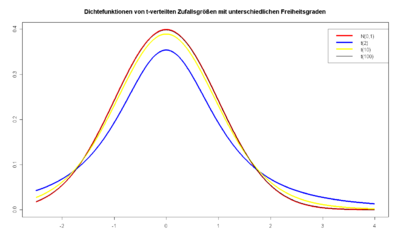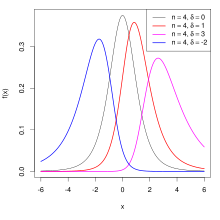Student's t-distribution
The Student t-distribution (also Student t-distribution or t-distribution for short) is a probability distribution developed in 1908 by William Sealy Gosset and named after his pseudonym Student.
Gosset had found that the standardized estimator of the sample mean of normally distributed data is no longer normally distributed but 

The 





The derivation was first published in 1908, when Gosset was working at the Guinness brewery in Dublin. Since his employer did not permit its publication, Gosset published it under the pseudonym Student. The t-factor and the associated theory were first proven by the work of R. A. Fisher, who called the distribution Student's distribution.
However, the 
Definition
A continuous random variable 


owns. Thereby is
the gamma function. For natural numbers 


Alternatively, the 


where 


Distribution
The distribution function can be expressed in closed form as
or as
with
where 




Properties
Let be 



Turning Points
The density has inflection points at
Median
The median is
Mode
The mode results in
Symmetry
The Student's 
Expected value
For the expected value we get for
The expected value for does not exist.
Variance
The variance for results in
Skew
The skewness is for
Cambers
For kurtosis kurtosis β 

Moments
For the 


![\mu_k=\operatorname{E}([X-\operatorname{E}(X)]^k)](https://www.alegsaonline.com/image/a59ce4ef4c332d2470b232e924ff8a9121af3810.svg)
Relationship to beta distribution
The integral
is the incomplete beta function
where

with
If t goes to infinity, 
Non-central t-distribution
The size
with 



The parenthesis with the sum of hypergeometric functions can be written a bit simpler still, resulting in a shorter alternative expression for the density:
where 

The expected value for
and the variance (for
With δ 

Relationship with other distributions
Relationship to Cauchy distribution
For 


Relationship to Chi-Square Distribution and Standard Normal Distribution
The 
where denotes 




Distribution with heavy edges
The distribution belongs to the distributions with heavy edges.
Approximation by the normal distribution
As the number of degrees of freedom increases, the distribution values of the 

Use in mathematical statistics
Various estimators are 
If the independent random variables 


and the sample variance
are stochastically independent.
Because the random variable 


by definition is 

So the distance of the measured mean from the mean of the population is distributed as 

where 



![{\displaystyle \left(\mu \in \left[{\overline {x}}\pm 1{,}96\cdot {\tfrac {\sigma }{\sqrt {n}}}\right]\right)}](https://www.alegsaonline.com/image/273f350dfa3a53d6c8af82274d94fcd39a6a749e.svg)
Density derivation
The probability density of the 


With the transformation
get the joint density of 


The Jacobian determinant of this transformation is:
The value 
We are now looking for the marginal distribution as an 

Selected quantiles of the t-distribution
Tabulated are 


Due to the mirror symmetry of the density, one only needs to adjust the probability scale for the case of the interval bounded symmetrically on both sides. Thereby the probabilities decrease for the same 


If in a sample 


To the number of degrees of freedom 





One-sided:
Two-sided:
So, for example, with 


The quantile function of the 


with 

For few values 
Table of some t-quantiles
→ Main article: Quantile table
| NumberDegrees of freedom | P for two-sided confidence interval | |||||||
| 0,5 | 0,75 | 0,8 | 0,9 | 0,95 | 0,98 | 0,99 | 0,998 | |
| P for one-sided confidence interval | ||||||||
| 0,75 | 0,875 | 0,90 | 0,95 | 0,975 | 0,99 | 0,995 | 0,999 | |
| 1 | 1,000 | 2,414 | 3,078 | 6,314 | 12,706 | 31,821 | 63,657 | 318,309 |
| 2 | 0,816 | 1,604 | 1,886 | 2,920 | 4,303 | 6,965 | 9,925 | 22,327 |
| 3 | 0,765 | 1,423 | 1,638 | 2,353 | 3,182 | 4,541 | 5,841 | 10,215 |
| 4 | 0,741 | 1,344 | 1,533 | 2,132 | 2,776 | 3,747 | 4,604 | 7,173 |
| 5 | 0,727 | 1,301 | 1,476 | 2,015 | 2,571 | 3,365 | 4,032 | 5,893 |
| 6 | 0,718 | 1,273 | 1,440 | 1,943 | 2,447 | 3,143 | 3,707 | 5,208 |
| 7 | 0,711 | 1,254 | 1,415 | 1,895 | 2,365 | 2,998 | 3,499 | 4,785 |
| 8 | 0,706 | 1,240 | 1,397 | 1,860 | 2,306 | 2,896 | 3,355 | 4,501 |
| 9 | 0,703 | 1,230 | 1,383 | 1,833 | 2,262 | 2,821 | 3,250 | 4,297 |
| 10 | 0,700 | 1,221 | 1,372 | 1,812 | 2,228 | 2,764 | 3,169 | 4,144 |
| 11 | 0,697 | 1,214 | 1,363 | 1,796 | 2,201 | 2,718 | 3,106 | 4,025 |
| 12 | 0,695 | 1,209 | 1,356 | 1,782 | 2,179 | 2,681 | 3,055 | 3,930 |
| 13 | 0,694 | 1,204 | 1,350 | 1,771 | 2,160 | 2,650 | 3,012 | 3,852 |
| 14 | 0,692 | 1,200 | 1,345 | 1,761 | 2,145 | 2,624 | 2,977 | 3,787 |
| 15 | 0,691 | 1,197 | 1,341 | 1,753 | 2,131 | 2,602 | 2,947 | 3,733 |
| 16 | 0,690 | 1,194 | 1,337 | 1,746 | 2,120 | 2,583 | 2,921 | 3,686 |
| 17 | 0,689 | 1,191 | 1,333 | 1,740 | 2,110 | 2,567 | 2,898 | 3,646 |
| 18 | 0,688 | 1,189 | 1,330 | 1,734 | 2,101 | 2,552 | 2,878 | 3,610 |
| 19 | 0,688 | 1,187 | 1,328 | 1,729 | 2,093 | 2,539 | 2,861 | 3,579 |
| 20 | 0,687 | 1,185 | 1,325 | 1,725 | 2,086 | 2,528 | 2,845 | 3,552 |
| 21 | 0,686 | 1,183 | 1,323 | 1,721 | 2,080 | 2,518 | 2,831 | 3,527 |
| 22 | 0,686 | 1,182 | 1,321 | 1,717 | 2,074 | 2,508 | 2,819 | 3,505 |
| 23 | 0,685 | 1,180 | 1,319 | 1,714 | 2,069 | 2,500 | 2,807 | 3,485 |
| 24 | 0,685 | 1,179 | 1,318 | 1,711 | 2,064 | 2,492 | 2,797 | 3,467 |
| 25 | 0,684 | 1,178 | 1,316 | 1,708 | 2,060 | 2,485 | 2,787 | 3,450 |
| 26 | 0,684 | 1,177 | 1,315 | 1,706 | 2,056 | 2,479 | 2,779 | 3,435 |
| 27 | 0,684 | 1,176 | 1,314 | 1,703 | 2,052 | 2,473 | 2,771 | 3,421 |
| 28 | 0,683 | 1,175 | 1,313 | 1,701 | 2,048 | 2,467 | 2,763 | 3,408 |
| 29 | 0,683 | 1,174 | 1,311 | 1,699 | 2,045 | 2,462 | 2,756 | 3,396 |
| 30 | 0,683 | 1,173 | 1,310 | 1,697 | 2,042 | 2,457 | 2,750 | 3,385 |
| 40 | 0,681 | 1,167 | 1,303 | 1,684 | 2,021 | 2,423 | 2,704 | 3,307 |
| 50 | 0,679 | 1,164 | 1,299 | 1,676 | 2,009 | 2,403 | 2,678 | 3,261 |
| 60 | 0,679 | 1,162 | 1,296 | 1,671 | 2,000 | 2,390 | 2,660 | 3,232 |
| 70 | 0,678 | 1,160 | 1,294 | 1,667 | 1,994 | 2,381 | 2,648 | 3,211 |
| 80 | 0,678 | 1,159 | 1,292 | 1,664 | 1,990 | 2,374 | 2,639 | 3,195 |
| 90 | 0,677 | 1,158 | 1,291 | 1,662 | 1,987 | 2,368 | 2,632 | 3,183 |
| 100 | 0,677 | 1,157 | 1,290 | 1,660 | 1,984 | 2,364 | 2,626 | 3,174 |
| 200 | 0,676 | 1,154 | 1,286 | 1,653 | 1,972 | 2,345 | 2,601 | 3,131 |
| 300 | 0,675 | 1,153 | 1,284 | 1,650 | 1,968 | 2,339 | 2,592 | 3,118 |
| 400 | 0,675 | 1,152 | 1,284 | 1,649 | 1,966 | 2,336 | 2,588 | 3,111 |
| 500 | 0,675 | 1,152 | 1,283 | 1,648 | 1,965 | 2,334 | 2,586 | 3,107 |
| | 0,674 | 1,150 | 1,282 | 1,645 | 1,960 | 2,326 | 2,576 | 3,090 |
Questions and Answers
Q: What is Student's t-distribution?
A: Student's t-distribution is a probability distribution which was developed by William Sealy Gosset in 1908. It describes samples drawn from a full population, and the larger the sample size, the more it resembles a normal distribution.
Q: Who developed Student's t-distribution?
A: William Sealy Gosset developed Student's t-distribution in 1908. He used the pseudonym "Student" when he published the paper describing it.
Q: What are some of the uses of Student's t-distribution?
A: The Student's t-distribution plays a role in many widely used statistical analyses, including the Student's t-test for assessing the statistical significance of differences between two sample means, constructing confidence intervals for differences between two population means, and linear regression analysis. It also arises in Bayesian analysis of data from a normal family.
Q: How does sample size affect the shape of a t-distribution?
A: The larger the sample size, the more closely it will resemble a normal distribution. For each different sample size there is an associated unique t-distribution that describes it.
Q: Is there any relation between Student’s T Distribution and Normal Distribution?
A: Yes - while normal distributions describe full populations, student’s T Distributions describe samples drawn from those populations; as such they share similarities but differ depending on their respective sizes. As mentioned above, larger samples tend to look more like normal distributions than smaller ones do.
Q: Is there any other name for this type of distribution?
A: No - this type of distribution is known as "Student's T Distribution," named after its developer William Sealy Gosset who used his pseudonym "Student" when publishing his paper about it.
Search within the encyclopedia

















































